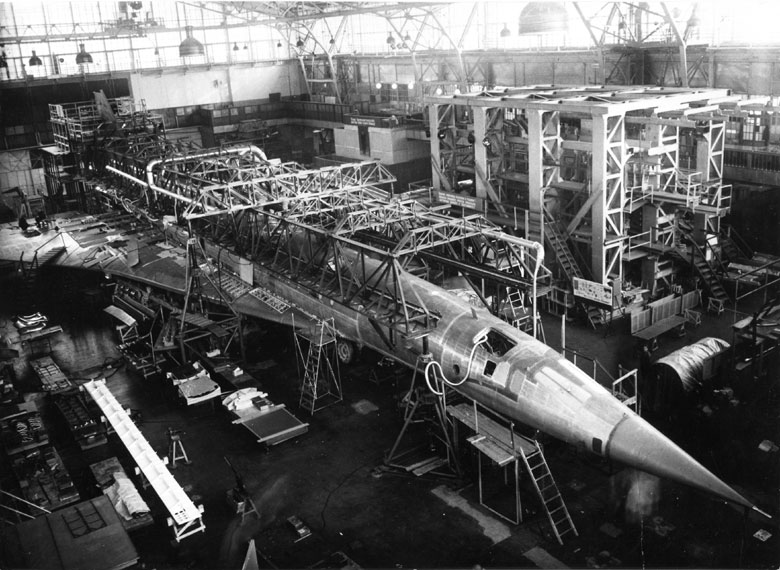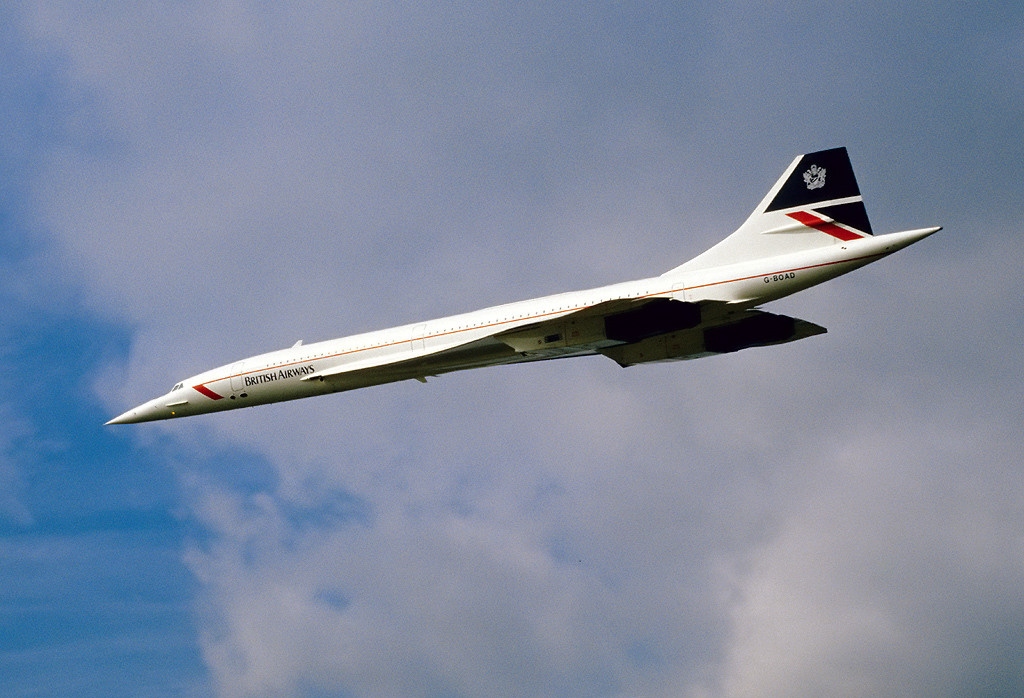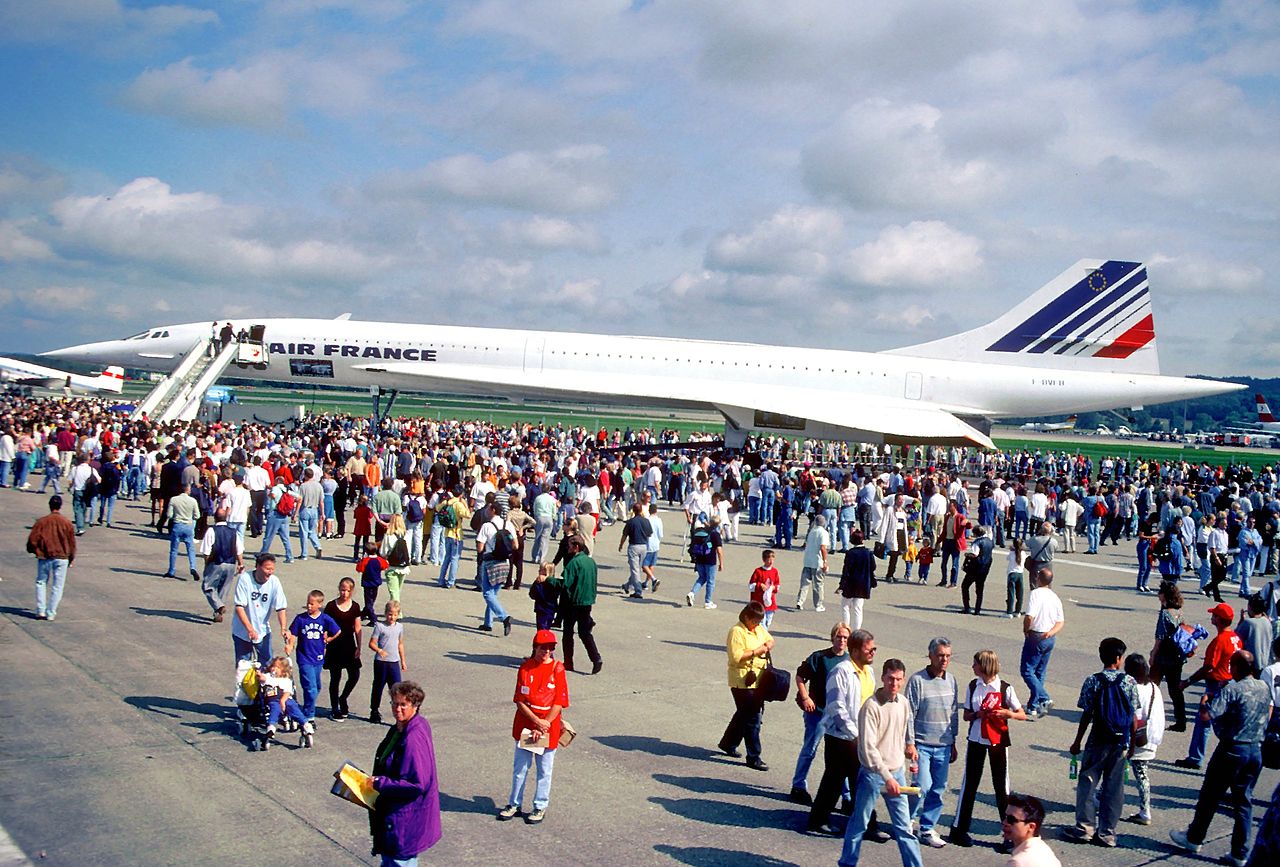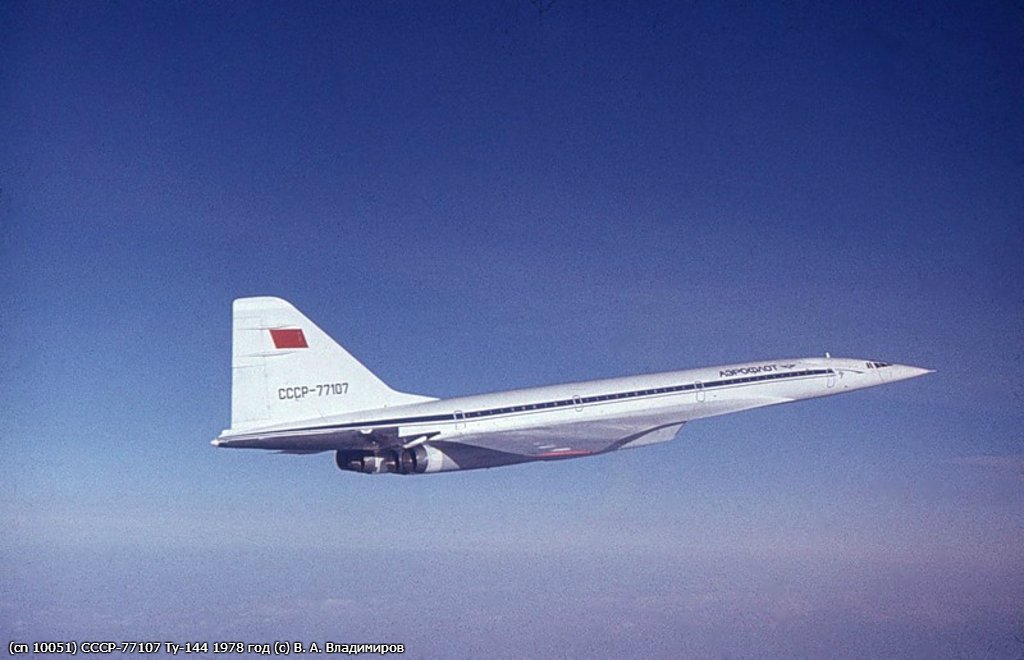History of the Legendary Aircraft
A Long Journey into the Sky: the Tu-144 Creation History
 |
| Tu-144 prototype in its maiden flight. Photo by Tupolev PJSC |
The Tupolev Tu-144 is a Soviet supersonic transport aircraft (SST). It is the first and one of only two SSTs in the world to enter commercial service.
The design and development of the Tu-144 is the largest and most complicated project in the history of Soviet aircraft construction. As a result of long-term work, it was possible to create an aircraft of the highest world class: in terms of its basic performance characteristics, not inferior to the corresponding aircraft, Concorde, created in the West.
Alexei Tupolev, the son of the famed Soviet aircraft pioneer, Andrei Tupolev, was appointed the chief designer for the aircraft. The development of the engine was entrusted to the Kuznetsov Design Bureau.
On July 16, 1963 the Council of Ministers of the USSR issued a decree "On the development of the Tu-144 SST with four jet engines and the construction of a batch of such aircraft in the Tupolev Design Bureau." The general management was carried out by Andrey Tupolev.
In July 1965, the preliminary design of the Tu-144 was ready.
On June 22, 1966 the full-size model of the aircraft was approved.
On October 9, 1968 the first prototype was completed.
On 31 December, 1968, two months before the flight of its Anglo-French rival – Concorde, the Tu-144 has performed its maiden flight from the airfield near Moscow (the flight was carried out by the prototype with СССР-68001 tail number).
The Tu-144 first went supersonic on June 5, 1969 becoming the first passenger airliner in history to overcome the sound barrier (at an altitude of 11,000 meters).
 |
| Assemblage of the Tu-144. Photo by Tupolev PJSC |
In the spring of 1971 the pre-production Tu-144 aircraft has been assembled in Zhukovsky, Moscow region. In 1972, the serial production began at the Voronezh Aircraft Plant. A total of 16 aircraft were built. On July 1, 1971, the first flight of the improved (serial) model of Tu-144 aircraft No. 01-1, tail number 77101, took place.
On October 29, 1977 the aircraft received the airworthiness certificate (for the first time in the USSR).
The first commercial flight of the Tu-144 with passengers onboard was carried out on November 1, 1977 from Moscow to Alma-Ata. That event has marked the beginning of the regular commercial operation of the Tu-144. On June 1, 1978, the management of Aeroflot decided to permanently stop passenger flights on Tu-144s.
In July 1983, Tu-144D modification of the aircraft set 13 world aviation records. From 1995 to 1999, one heavily modified Tu-144D (No. 77114), designated Tu-144LL ("Flying Laboratory") was used by NASA to research high-speed commercial flights in order to develop a plan for creating a new modern supersonic passenger aircraft.
Until the mid-1990s, Tu-144s were used for various tests. At the request of the Ministry of Science and by the decision of the Ministry of the aircraft industry of the USSR, several aircrafts were installed as exhibits on the territory of the Air Force Museum in Monino, the Civil Aviation Museum in Ulyanovsk, aircraft plants in Voronezh, Kazan and Samara. One aircraft was sold to a private engineering museum in Sinsheim (Germany).
Tu-144 versus Concorde
 |
| British Airways Concorde at the Farnborough air show, UK, 1986. Photo by Tim Rees |
The only aircraft in the world comparable to the Tu-144 in its performance characteristics, was the British-French Concorde. It was jointly developed and manufactured by French company Sud Aviation (later Aérospatiale) and the British Aircraft Corporation (BAC) under an Anglo-French treaty. Rolls-Royce / SNECMA Olympus 593 engines were jointly developed by the British company Rolls-Royce and the French company SNECMA.
In total, 20 Concordes were produced, 14 of them were operated on commercial airlines by British Airways and Air France, each of which had seven aircraft.
Concorde’s maiden flight was conducted on March 2, 1969, two months later than the Soviet Tu-144. The commercial use of the Concordes started on January 21, 1976 by flight from London to Bahrain. Since 1977, Concorde began to fly from Europe to New York.
Tu-144 and the Concorde are very similar in terms of exterior: long fuselage, droop-nose section, tailless shape. But there are a lot of differences too. "They are very similar in many respects," Alexey Tupolev, Tu-144’s chief designer said in an interview to "Tekhnika Molodezhi" popular science magazine in 1969. "There is nothing surprising – both aircraft represent the same class: the numbers of passengers, speed, flight altitude, weight, are almost identical. The identity of the main characteristics has also caused the similarity in exterior. However, we made some features differently."
"Four Tu-144’s engines are placed under the fuselage," he continues. "Concorde's engines are located in pairs on the wing consoles. The "central" layout, in our opinion, is more successful. In case one of the engines stops, the aircraft is easier kept from turning when all engines are located in the central part"
"The main landing gears of Tu-144 are retracted in the direction of flight to the wing. On the "Concorde", the gears are retracted in the fuselage. Our solution is not just a design whim. Applying such a scheme, we freed the fuselage. As a result, we have five passenger seats in a row instead of four in an Anglo-French aircraft."
 |
| Air France Concorde in Zurich, Switzerland, 1998. Photo by Aero Icarus |
Only two out of 16 Tu-144s – 77109 and 77110 – ever flew on passenger lines on the Moscow – Alma-Ata route. Tu-144 conducted the first passenger flight on November 1, 1977. Flights to a distance of 3260 km at an altitude of 16 000-17 000 m at a speed of 2000 km/h were carried out once a week, the number of passengers on board did not exceed 80 people. Until the cessation of regular commercial operation in May 1978, Aeroflot crews performed 55 flights on the Tu-144, transporting 3,284 passengers.
The commercial use of Tu-144’s European rival, Concorde, proved to be much more lasting and successful. For 27 years of regular and charter flights Concordes carried about 2,5 million passengers, the total flight time was 243,845 hours. The career of the British-French aircraft came to an end only at the beginning of the 21st century. On July 25, 2000, the Concorde aircraft crashed on departure from the Paris Charles de Gaulle airport. 113 people including 100 passengers and 9 crew members died. Finally, Concordes left passenger routes in November 2003 due to the increase in fuel prices.
Interesting information on comparing Tu-144 and Concorde can be found on the Tupolev PJSC website:
"It is interesting to compare the fate of the Tu-144 and the Anglo-French Concorde. Both machines are close in design and time of creation. First of all, it should be noted that Concorde was designed primarily for supersonic flights over uninhabited oceanic expanses (flights between Europe and America across the Atlantic Ocean). That made possible to choose smaller altitudes of cruising in supersonic speed (while more strict sonic boom restrictions should be taken into account when flying over land) and, as a consequence, smaller wing area, smaller take-off mass, smaller required cruise thrust and fuel costs.
Tu-144 was to fly primarily over land, hence the higher flight altitudes were required. It caused the increase in parameters. Add here less advanced engines (in terms of their specific parameters, the Tu-144 engines became comparable to Olympus engines of Concorde only in the latest versions) and specific parameters of domestic equipment and aircraft assemblies in comparison with western ones. All these negative initial moments were largely compensated for by the high perfection of the aerodynamics of the Tu-144. In terms of the obtained aerodynamic quality during flights at the cruise supersonic mode the Tu-144 was superior to the Concorde. But it caused complication of the airplane structure and the decrease of the level of manufacturability of the aircraft in production.
The numbers of serial Tu-144 and Concordes were approximately equal, but unlike the Tu-144, the Anglo-French aircrafts were in operation, albeit subsidized by the government, almost until the early 1990s. The cost of the ticket on the route from London to New York in 1986 was 2745 US dollars. Only very wealthy and busy people, for whom the formula "time is money" is the main credo of existence, could buy such expensive tickets. In the West, there are such people, and for them flights onboard the Concorde are a natural saving of time and money. 325 000 flight hours of Concordes in commercial routes to 1989 prove that.
As a result, we can assume that the Concorde program for the Anglo-French was sufficiently commercial and to some extent it was an element of prestige.
In the USSR, rich businessmen, for whom time would turn into money, were not present, so the natural service market, which was supposed to satisfy the Tu-144, simply did not exist in the Soviet Union. The aircraft was obviously to become largely subsidized and unprofitable in operation in Aeroflot. Therefore, the program for creating the Tu-144 in large part can be attributed as an element of national prestige, which was not provided with real economic needs of the domestic market of aviation services."
| Tu-144 (in the foreground) and Concorde in the museum in Sinsheim, Germany. Photo by Apocalyps |
It is worth noting that the project of supersonic passenger aircraft was developed in the 1960s in the USA. In the National Supersonic Transport program in 1966, the state commission chose the Boeing project (the other two were made by North American and Lockheed). The Boeing-2707 aircraft was to have a cruising speed of 2.7 Mach (2900 km/h) at a range of up to 6,740 km and passenger capacity of up to 277 people (up to 300 in version 733-390). However, the combination of various factors, one of the main being the desire to reduce budget expenditures, led to the fact that in 1971 the development of the machine was stopped at the stage of construction of the second prototype. Thus, the Tu-144 and Concorde remained the world's only materialized projects of supersonic passenger aircraft.
Tu-144 and Concorde specifications table
|
Tu-144 ("044") (prototype) |
Tu-144S (Serial modification with NK-144А engines) |
Tu-144D (Modification with RD-36-51A engines) |
Tu-144LL (Test aircraft with NK-32-1 engines) |
Concorde | |
| Maiden flight | December 31, 1968 | June 1, 1971 | November 30, 1974 | November 29, 1996 | March 2, 1969 |
| Crew | 4 | 4 | 4 | 4 | 3 |
| Length (meters) | 59,4 | 65,7 | 65,7 | 65,7 | 61,66 |
| Height (meters) | 11,4 | 12,5 | 12,5 | 12,5 | 12,2 |
| Wingspan (meters) | 27,65 | 28 | 28,8 | 28,8 | 25,6 |
| Wing area, (square meters) | 469,8 | 503 | 507 | 506 | 358,6 |
| Maximum takeoff weight, kg | 160 000 | 195 000 | 207 000 | 207 000 | 185 000 |
| Maximum payload, kg | 12 000 | 15 000 | 13 000-15 000 | 13 380 | |
| Maximum weight of fuel, kg | 76 000 | 98 000 | 95 680 | ||
| Number of engines | 4 | 4 | 4 | 4 | 4 |
| Type of engines | NK-144 | NK-144A | RD-36-51A | NK-32-1 |
Olympus 593 |
| Maximum thrust, kN, per engine | 171,6 | 178 | 196,1 | 245 | 170 |
| Maximum thrust during supersonic regime, kN, per engine | 127,5 | 147 | 137,5 | ||
| Maximum speed, km/h | 2443 | 2500 | 2285 | 2330 | |
| Operating cruise speed (in supersonic regime) km/h | 2200 | 2000-2350 | 2124 | 2145 | 2150 |
| Landing speed, km/h | 290 | 280 | 290 | 295 | |
| Range, km | 2920 | 3080 | 5330 | 4000 | 7200 |
| Service ceiling, m | 18 500 | 18 200-18 750 | 16 200-18 400 | 17 800 | 18 300 |
Note: СССР-77107 aircraft, which is installed on KNRTU-KAI campus, belongs to Tu-144S modification
History of the СССР-77107 aircraft
 |
| СССР-77107 in flight, 1978. Photo by Vladimir Vladimirov |
The Tu-144 with the tail number 77107 (serial number 05-1) is the representative of the family of the world's first supersonic passenger aircraft developed in the Soviet Union in the Tupolev Design Bureau. It was built in 1975 at the Voronezh Aircraft Plant No. 64. The aircraft made its first flight the same year. Its operator was the Ministry of Aviation Industry (MAP) of the USSR and Zhukovsky flight test base under the Tupolev Design Bureau.
After factory tests and tests on various programs, in 1977 the aircraft was presented as a complex platform for joint state tests. According to the results of these tests, it was noted that the flight performance of the aircraft, with the exception of the practical range of flight with a specified number of passengers, takeoff weight, corresponds to the requirements set for the Tu-144 (during tests, a practical range of supersonic flight with a takeoff weight of 195 tons was measured as 3080 km at commercial load 15 tons, and 3600 km at 7 tons). It was emphasized that the flight range of 4000-4500 km cannot be realized with a commercial load of 14-15 tons with NK-144A engines. But it also was emphasized that reaching such a range is possible with RD-36-51A engines. The decision has been made by the Ministry of Aviation Industry and the Ministry of Civil Aviation on the commencement of passenger transportation by Tu-144 aircraft with NK-144A.
The aircraft performed standard flights reaching the maximum speed (up to 2,35 Mach). Stability and controllability were estimated at maximum permissible centerings, a control evaluation of the takeoff and landing characteristics was also carried out. Range test flights were also performed. During the tests СССР-77107 performed 180 flights (out of 150 planned) with a total flight time of 357 hours (out of 250 planned), of which 135 hours on supersonic speed.
From December 1979 to February 1980 СССР-77107 was used as a test platform for a new type of brakes, for which graphite disks were first installed. The brakes were capable of not overheating at high temperatures. In 1981 it performed test flights in Domodedovo.
In the summer of 1982, alongside СССР-77108 it performed test flights in Domodedovo to develop the Automatic Onboard Management System (ABSU) in cooperation with the State Research Institute of Civil Aviation (GosNII GA).
Since 1982 the aircraft was in storage at the Flight Research Institute named after M. M. Gromov. In 1985, it was transferred to the Kazan Aviation Institute (KAI). On March 29, 1985 it has made its last flight to Kazan landing at the airfield of Kazan Aircraft Plant named after S. P. Gorbunov under the command of captain V. N. Matveev.
On April 12, KNRTU-KAI signed the Handover Protocol for the Tu-144 to be used for educational purposes. In August 1985, the machine was installed near the 6th building of KNRTU- KAI. The university was also involved in the design and research of the aircraft. In May 1982 the university signed a contract with the Tupolev Design Bureau. KNRTU-KAI faculty, prof. V. Pavlov and Dr. L. Semakov, calculated the maneuver for maintaining a given flight altitude when changing the regime of the engine to the "small gas" mode in the event of failure of hydraulic systems in the longitudinal channel.
Timeline of transportation to KNRTU-KAI campus
- July 13, 2016 – dismantling of aircraft elements began.
- October 19 – airplane nose was dismantled and transported.
- November 2 – the NK-144 engines weighing 3,5 tons each got disassembled.
- November 16 – one of the engines was transported to KNRTU-KAI campus.
- November 21 – wings were dismantled and transported.
- April 14-15 – transportation of the fuselage.
- April 17 – vertical stabilizer, the last element, was transported.
Sources: "Tupolev" PJSC, Aviahistory, concordesst.com, tu144sst.com